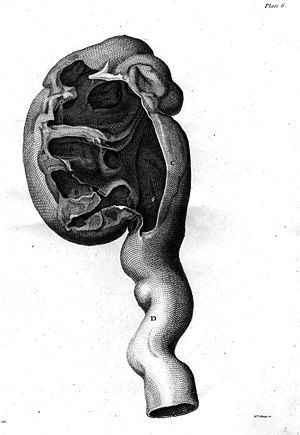신장염
Nephritis| 신장염 | |
|---|---|
 | |
| 신장확대(해부절제술) | |
| 전문 | 신장학 |
| 종류들 | 사구체신염[1] 및 간질신염[2] |
| 진단 방법 | 초음파, 엑스레이[3] |
| 치료 | 유형에 따라 다름(유형 참조) |
신장염은 신장의 염증으로 사구체, 세관 또는 사구체와 [4]세관을 둘러싼 간질 조직을 포함할 수 있다.그것은 여러 종류의 신증 중 하나이다.
종류들
- 사구체신염은 사구체의 염증이다.사구체신염은 조건 [1]없이 "신염"이라는 용어를 사용할 때 종종 암시된다.
- 간질성 신장염(또는 [2]요세관 간질성 신장염)은 신장관 사이의 공간에 생기는 염증이다.
원인들
신장염은 종종 감염과 독소에 의해 발생하지만,[5] 신장과 같은 주요 장기에 영향을 미치는 자가면역 장애에 의해 가장 흔하게 발생한다.
- 신우신염은 [6]신장의 신골반까지 도달하는 요로 감염에 의한 염증입니다.
- 루푸스신염은 면역체계 [7]질환인 전신성 홍반성 루푸스(SLE)에 의한 신장의 염증이다.
- 운동신염은 격렬한 [8]운동으로 인한 신장염이다.격렬한 운동 후 혈뇨는 적혈구 외상에 의한 3월 헤모글로빈뇨로 인해 발생할 수 있으며, 적혈구 파열로 인해 헤모글로빈이 [9]소변으로 방출됩니다.
메커니즘
신장염은 사구체 구조를 염증성 세포 [10]증식으로 교란시킴으로써 사구체 손상을 일으킬 수 있다.이는 사구체 혈류 감소로 이어져 소변 배출량 감소(올리뇨)[11]와 노폐물 보유(요독증)[12]를 초래할 수 있습니다.그 결과 손상된 사구체에서 적혈구가 새어나와 소변에 혈액이 나타날 수 있다(혈뇨).[13]
낮은 신장 혈류는 레닌-안지오텐신-알도스테론 시스템(RAAS)을 활성화하여 체액 유지와 가벼운 [14]고혈압을 일으킨다.신장이 불타면서, 그들은 영향을 받은 개인의 몸에서 소변으로 필요한 단백질을 배출하기 시작합니다.이 상태를 [15]단백뇨라고 합니다.
신장염으로 인해 필요한 단백질이 손실되면 생명을 위협하는 여러 가지 증상이 나타날 수 있습니다.신장염의 가장 심각한 합병증은 혈액이 과도하게 응고되는 것을 막는 단백질의 현저한 손실이 있을 때 발생할 수 있다.이러한 단백질의 손실은 혈전을 일으켜 갑작스러운 [16]뇌졸중을 일으킬 수 있다.
진단.
진단은 신장염의 원인에 따라 다르며, 낭창성 신장염의 경우 혈액 검사, 엑스레이, 초음파를 통해 그 [3]상태를 확인할 수 있다.
치료
신장염의 치료(또는 관리)는 신장의 염증을 유발한 요인에 따라 달라집니다.낭창신염의 경우 히드록시클로로킨을 사용할 [18]수 있습니다.
유병률
신장염은 미국의 모든 여성들 사이에서 9번째로 흔한 사망 원인이다.[19]
전 세계적으로 신장염의 가장 높은[clarification needed] 발병률은 아프리카 또는 아시아 혈통의 50-55%이며, 히스패닉 43%, 백인 17%[20]가 그 뒤를 잇다.
신장염(이 경우 낭창신염) 진단을 받은 사람의 평균 연령은 28.[21]4세이다.
「 」를 참조해 주세요.
레퍼런스
- ^ a b "Glomerulonephritis: MedlinePlus Medical Encyclopedia". www.nlm.nih.gov. Retrieved 2015-06-14.
- ^ a b "Interstitial nephritis: MedlinePlus Medical Encyclopedia". www.nlm.nih.gov. Retrieved 2015-06-14.
- ^ a b "American College of Rheumatology guidelines for screening, treatment, and management of lupus nephritis. National Guideline Clearinghouse". www.guideline.gov. Archived from the original on 15 September 2016. Retrieved 23 July 2016.
- ^ Keto Acids – 연구 및 응용 분야 발전 2013년판 페이지 220e
- ^ "Acute Nephritis; Nephrosis; Nephritic syndrome information. Patient Patient". Patient. Retrieved 23 July 2016.
- ^ "Pyelonephritis: Kidney Infection". www.niddk.nih.gov. Retrieved 2015-06-14.
- ^ "Lupus Nephritis". www.niddk.nih.gov. Archived from the original on 2017-01-04. Retrieved 2015-06-14.
- ^ "Nephritis Symptoms". esagil.org.
- ^ Shinton, N. K. (2007). Desk Reference for Hematology. CRC Press. ISBN 9781420005127. Retrieved 2019-02-14.
- ^ "Glomerular Diseases". www.niddk.nih.gov. Retrieved 2015-06-15.
- ^ "Oliguria: Background, Etiology, Epidemiology". Medscape. eMedicine. Retrieved 23 July 2016.
- ^ "uremia accumulation in the blood of constituents normally eliminated in the urine that produces a severe toxic condition and usually occurs in severe kidney disease". www.merriam-webster.com. Retrieved 2015-06-14.
- ^ "Hematuria (Blood in the Urine)". www.niddk.nih.gov. Retrieved 2015-06-14.
- ^ Ashar, Bimal; Miller, Redonda; Sisson, Stephen; Hospital, Johns Hopkins (2012-02-20). Johns Hopkins Internal Medicine Board Review: Certification and Recertification. Elsevier Health Sciences. ISBN 978-0323087988.
- ^ "Proteinuria". www.niddk.nih.gov. Retrieved 2015-06-14.
- ^ Jr, Donald E. Thomas (2014-05-22). The Lupus Encyclopedia: A Comprehensive Guide for Patients and Families. JHU Press. ISBN 9781421409849.
- ^ "WHO Disease and injury country estimates". World Health Organization. 2009. Retrieved Nov 11, 2009.
- ^ "Hydroxychloroquine: MedlinePlus Drug Information". medlineplus.gov. Retrieved 23 July 2016.
- ^ "Leading Causes of Death - Women's Health USA 2010". mchb.hrsa.gov. Retrieved 2015-06-14.
- ^ Lerma, Edgar; Rosner, Mitchell (2012-10-28). Clinical Decisions in Nephrology, Hypertension and Kidney Transplantation. Springer Science & Business Media. ISBN 9781461444541.
- ^ "Lupus Nephritis: Practice Essentials, Background, Pathophysiology". 2018-04-22.
{{cite journal}}:Cite 저널 요구 사항journal=(도움말)




